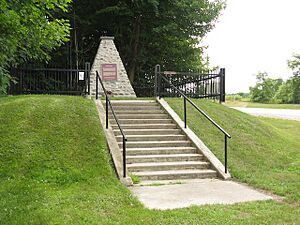Battle of Longwoods facts for kids
Quick facts for kids Battle of Longwoods |
|||||||
|---|---|---|---|---|---|---|---|
| Part of the War of 1812 | |||||||
|
|||||||
| Belligerents | |||||||
Native Americans |
|||||||
| Commanders and leaders | |||||||
| James Lewis Basden | Andrew Holmes | ||||||
| Strength | |||||||
| 240 | 164 | ||||||
| Casualties and losses | |||||||
| 14 killed 52 wounded (including 1 prisoner) 1 missing |
4 killed 3 wounded |
||||||
The Battle of Longwoods was a fight during the War of 1812 between the United States and Great Britain. It happened on March 4, 1814. An American raiding group on horseback defeated British soldiers, Canadian volunteers, and First Nations warriors. This battle took place near what is now Wardsville, in Southwest Middlesex, Ontario.
How the Battle Started
After the American navy won the Battle of Lake Erie in October 1813, an American army took back Detroit. They also captured a British fort at Amherstburg. The British and their Native American allies were defeated at the Battle of the Thames.
The British worried the Americans might attack their position at Burlington, Ontario. But many American soldiers' enlistment time was ending, so they went home. This left a large area of land, about 200 miles long, with no clear control. Both sides sent out small groups to scout and fight.
In December 1813, the British set up outposts at Delaware and Port Talbot, Ontario. An American commander, Lieutenant Colonel Anthony Butler, sent Captain Andrew Holmes to capture one of these British posts. Holmes led a group of mounted soldiers, including rangers and militia. They wore buckskins and carried rifles and tomahawks.
The American Plan
Captain Holmes left Amherstburg on February 21. He moved along the shore of Lake Erie. The ground was very soft, so he had to leave his two cannons behind. After a small fight with some Canadian militia, Holmes decided to go for Delaware instead of Port Talbot. He thought the militia would warn Port Talbot's defenders.
By March 2, Holmes was about 15 miles from Delaware. But cold weather, hunger, and sickness had reduced his force from 180 to 164 men. The British had indeed been warned. Holmes learned that 300 British soldiers had left Delaware and were close by. Holmes sent some Michigan Rangers to guard the rear while his main group retreated five miles. The Rangers also fell back after a quick fight with Caldwell's Rangers, who were leading the British.
Some of Holmes's officers wanted to retreat even further. But Holmes decided to stand and fight. He chose a hill that overlooked a bridge over the Twenty Mile Creek. He built defenses using felled trees and branches, called an abatis.
On March 4, Caldwell's Rangers tried to trick the Americans. They fired a few shots and then pretended to retreat. Holmes chased them for about five miles. But the Michigan Militia Dragoons warned him that the British were planning an ambush. Holmes quickly returned to his strong position on the hill.
The Fight Begins
The full British force arrived at Twenty Mile Creek around 5 p.m. that day. The British had about 240 men. This included soldiers from the Royal Scots and the 89th Regiment of Foot. There were also Canadian volunteers like the Loyal Kent Volunteers and Caldwell's Western Rangers. About 44 First Nations warriors, including Wyandot and Potawatomi people, were also with them.
The British commander at Delaware was not there, so Captain James Lewis Basden of the 89th Regiment led the attack. Basden didn't know the area well, but he attacked right away. He ordered the Rangers and Volunteers to go around the Americans from the north. The Native warriors were to go around from the south. Basden himself led the regular soldiers straight towards the American front.
The Rangers, militia, and Native Americans crossed the creek and started fighting on the sides. The regular British soldiers fired at the American center, but it didn't do much. Basden then ordered a charge. As the British advanced towards the bridge, they were crowded together on the narrow road. The Americans fired heavily, hitting many of the leading soldiers.
Basden only saw the tree defenses (abatis) after crossing the bridge. Still, he led his men up the hill. But the British couldn't climb the icy slope while being shot at. They were forced back. Basden was wounded in the leg, and Captain Johnston, another British leader, was killed. The British soldiers then fell back into the ravine by the creek. They tried to shoot the Americans from behind trees, but the Americans were higher up and caused many casualties.
On the sides, the Native Americans did not push their attack hard. The Rangers had more success, but they were too few to attack the American position directly. As it got dark around 6:30 p.m., the entire British force retreated.
The British lost 14 killed, 51 wounded, 1 wounded prisoner, and 1 missing. The Americans had 4 killed and 3 wounded.
What Happened Next
Even though Captain Holmes won the battle, he knew he was outnumbered. He decided he couldn't capture the British post at Delaware. So, at 9 p.m., he left his position and retreated to Detroit. The British also later left their outpost at Delaware.
The two American cannons that Holmes had left behind were found by another Canadian militia group. They destroyed the carriages and hid the cannons in a swamp. They stayed there until the end of the war.
Holmes was promoted to Major. Sadly, he was killed a few months later at the Battle of Mackinac Island. Basden recovered from his wound and later fought in the Battle of Lundy's Lane.
Today, the battle site is a National Historic Site of Canada. It was given this special status in 1924.


